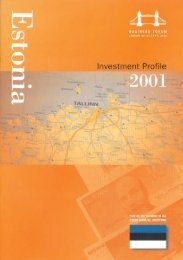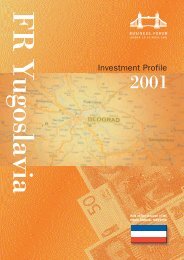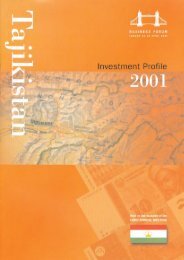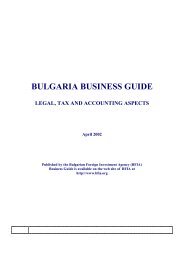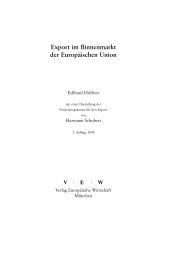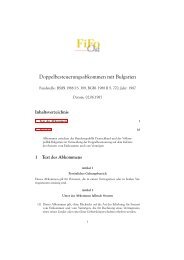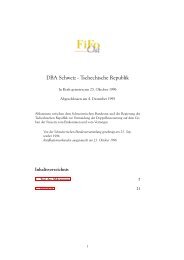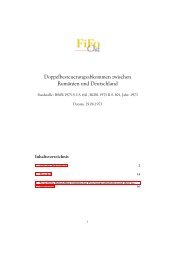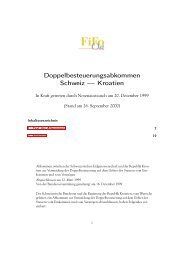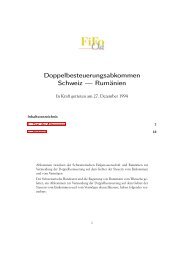Introduction - FiFo Ost
Introduction - FiFo Ost
Introduction - FiFo Ost
You also want an ePaper? Increase the reach of your titles
YUMPU automatically turns print PDFs into web optimized ePapers that Google loves.
a loan of € 32.7 million that was used to help the formulation<br />
and implementation of HZ's commercialisation strategy and to<br />
finance its most urgent investment needs. In 1998, a € 85.4<br />
million loan from the World Bank was also secured. The aim of<br />
the restructuring is to modernise and restructure HZ in order to<br />
decrease its debts and make it competitive. The restructuring<br />
project will be the first step in a full commercialisation and<br />
privatisation process.<br />
Within the Stability Pact's “quick start” package, electrification<br />
and resignalling of the North-South Railway Corridor is planned<br />
with financing of € 122 million from the EIB. The mid-term<br />
projects include upgrading of the North-South and the<br />
Northeast-Southwest Railway Corridor.<br />
Sea transport<br />
Maritime communications are an important mode of transport<br />
for Croatia, with its long coastline and large shipping fleet. Both<br />
cargo and passenger services declined in the mid-1990s,<br />
largely due to wartime disruption, but have started a gradual<br />
comeback in the last two years. The revival of the tourism<br />
sector and planned development of transport links with central<br />
Europe will strengthen the positive growth trends.<br />
Rijeka port development<br />
Rijeka, the country's largest port, was in the past a rail, road, air<br />
and maritime centre, and the key trading link for central Europe and<br />
the western Balkans. The port has lost more than half of its traffic in<br />
the 1990s, but plans are under way to re-establish Rijeka as central<br />
Europe's leading port. The planned upgrade of port facilities and<br />
railway and road links will greatly help to attract cargo from and for<br />
the landlocked countries of central Europe.<br />
In 2000, a Croatian-Hungarian strategic partnership took shape<br />
aimed at rehabilitating Rijeka port with the active participation of<br />
private companies. Ganz Port Rijeka, a consortium of Hungarian and<br />
Croatian companies, plans to develop and partly operate Rijeka port<br />
in cooperation with the Croatian authorities under a concession<br />
agreement for the construction of a new soya terminal. Hungarian<br />
steel company Ganz Acel Rt has a 51 per cent share in Ganz Port<br />
Rijeka, while the remaining stake is held by Luka Rijeka, the firm<br />
that currently operates the port. The consortium plans to invest<br />
US$ 70-80 million in the construction of two large silos, deploying<br />
six new cranes and renovating 43 existing cranes.<br />
Rijeka port has two free trade zones, the second of which opened in<br />
2000 and will include a timber processing plant and cattle and<br />
general cargo transhipment terminals.<br />
Foreign retail groups in Croatia<br />
Name Country of origin Facilities<br />
Major sectors of the economy<br />
Segro Austria Three stores in Zagreb<br />
Billa Austria Two supermarkets in Zagreb<br />
10 more planned in 2000<br />
Mercatone Italy 1 giant shopping mall in Zagreb<br />
2 more to open in 2000<br />
Mercator Slovenia One hypermarket is planned.<br />
Drogerie markt Germany-Austria 25 outlets all over the country<br />
Marks & Spencer UK 1 department store in Zagreb<br />
opened in May 2000<br />
Leclerc France Plans to open three food super<br />
and hypermarkets<br />
Source: Reuters<br />
Retail<br />
Croatia has been experiencing a large retail boom in the last<br />
few years, as had happened earlier in neighbouring Slovenia<br />
and Hungary. A large number of foreign retailers have entered,<br />
attracted by high margins, the result of little existing<br />
competition, and the western-style consumer habits of Croatian<br />
customers that developed in the 1980s, as Croatians were<br />
permitted to travel freely even in communist times. The<br />
increasing competition is challenging the previous dominance of<br />
the two largest Croatian retail groups, Konzum (owned by the<br />
Agrokor food conglomerate) and Getro. This has stimulated the<br />
local retail market by encouraging Croatian citizens to shop at<br />
home rather than abroad.<br />
Agriculture and food processing<br />
Agriculture is a significant component of the Croatian economy,<br />
accounting for about 10 per cent of Croatia's GDP, while the<br />
food processing industry covers an estimated 7 per cent.<br />
Croatian agricultural production is characterised by three<br />
distinct agro-ecological regions. There are cultivated lowland<br />
regions, primarily used for growing cereals and sugarbeet,<br />
mountainous regions where pasture predominates and coastal<br />
areas, where viticulture, fruit and olive production are<br />
prominent. Fishing and fish processing has traditionally been<br />
important activities along the Adriatic coast. The sector was<br />
severely disrupted by the war, but production started to recover<br />
from 1998 onwards, although it is still lower than in the<br />
pre-war years.<br />
Unlike in most other formerly communist countries, farmers in<br />
Croatia were able to retain private ownership of land. Therefore,<br />
Croatia Investment Profile 15



